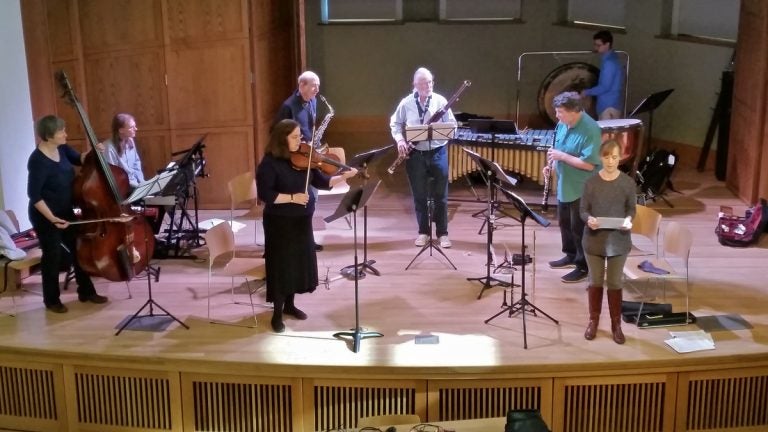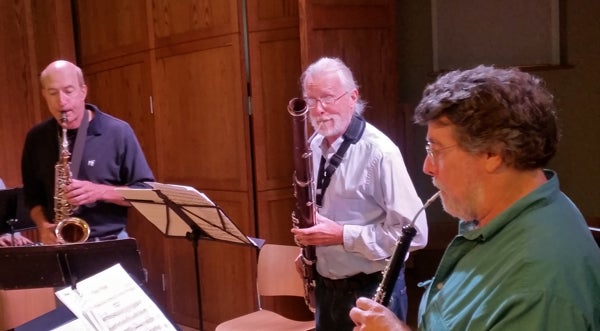Clay tablets at Penn museum tell jokes from Sumeria

The Relâche ensemble rehearses for its performance of 'Sumer Redux' at the Penn Museum. (Peter Crimmins/WHYY)
After 4,000 years of silence, the battle between the plow and the hoe will be rekindled at the University of Pennsylvania Museum of Archeology this weekend.
The Penn Museum has a vast collection of clay tablets with cuneiform writing from the ancient Sumerians, including one about farm tools arguing. Some of them will be put to music by the museum’s resident ensemble, Relache.
The clay tablets at the Penn Museum tell stories of the gods and kings of the Sumerians, in what is now Iraq. They also committed for eternity jokes, like an imagined dispute between a bird and a fish, or a plow and a hoe.
“They are written in perfectly formal Sumerian, but you can see the twinkle in the eye as they were writing them,” said Phillip Jones, associate curator and keeper of the Babylonian artifacts at the Penn Museum. He will serve as the on stage narrator in the museum’s Widener Hall.
“Oh, the hoe. Tied together with thongs. Made from poplar, tooth, and ash,” Jones read from the translated text.
The ensemble’s clarinet player, Bob Butryn, plays the part of the plow.
“Oh, hoe, with your poor little head stuck in the mud, weeding miserably with your crooked teeth in the muck,” he mocked.
The back-and-forth is punctuated with musical passages composed by Chuck Holdeman, who represented the plow with gently plucked strings of viola and bass, and the more “rammy” wind instruments for the hoe.
“He says, ‘You only work four months of the year, and the rest of the time you’re loafing in the shed,’” said Holdeman.
 Chuck Holdeman, on bassoon, composed ”Sumer Redux” in response to the text on two ancient cuneiform tablets in the Penn Museum collection. (Peter Crimmins/WHYY)
Chuck Holdeman, on bassoon, composed ”Sumer Redux” in response to the text on two ancient cuneiform tablets in the Penn Museum collection. (Peter Crimmins/WHYY)
I won’t tell you who wins this four thousand year-old fight, but this whimsical confection may have held deeper significance for the ancient Sumerians. It’s likely the story was told to entertain people just before the agricultural season began.
“They are arguing with each other, one-upmanship,” said Holdeman. “At the same time they reveal the enormous symbolic importance to the culture. The civilization could not exist without them.”
The piece, called Sumer Redux, will be performed with another piece written for an ancient text of a sermon by the high priestess Enheduana (2300 BCE), the controller of passions both creative and destructive.
The second part of the concert will be new music by composer Philip Johnston, to accompany select silent films of Georges Melies, ca. 1903, “The Merry Frolics of Satan,” “Hydrotherapie Fantastique,” and “The Damnation of Faust”
WHYY is your source for fact-based, in-depth journalism and information. As a nonprofit organization, we rely on financial support from readers like you. Please give today.





